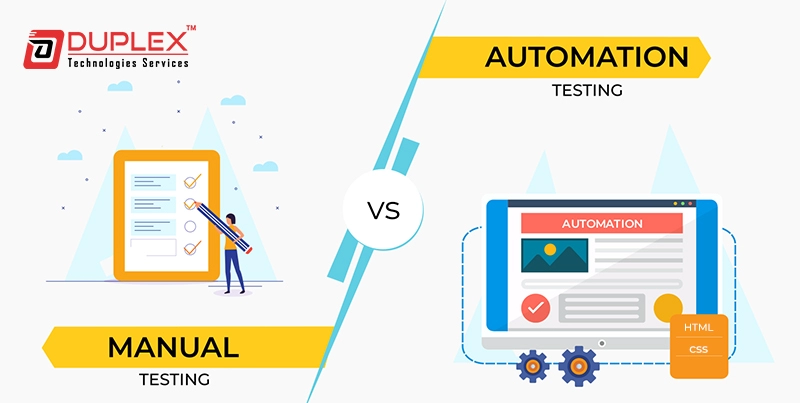Manual vs. automated testing: choosing the best one | Analysis of manual and automated testing | Duplex Technologies

Posted By : Ambesh Mishra, Posted Date : Sep 21, 2024
Introduction: manual vs. automated testing
Manual vs. automated testing, which one is better? We are going to discuss manual and automated testing in today’s blog to know this.
As much as technological advancement increases at high rates, the usage and the difficulty of software also increase greatly. This is because software testing is an effective way of ascertaining the reliability of the software, its security, and its performance. Thankfully, there are both manual and automated testing methods that a firm can select depending on the firm’s needs and necessities. By using both approaches, companies can ensure the delivery of high-quality software products that are in demand in today’s world that heavily relies on technology. Testing is no longer an expense that organizations can afford to avoid using or reducing because they are not very necessary.
Table of Contents
- What is manual testing?
- Benefits of manual testing | Manual testing vs. automated testing
- Uses of manual testing | Compare software testing methods
- Limitations of manual testing | Manual and automated testing
- What is automation testing?
- Benefits of automation testing | Manual testing vs. automated testing
- Uses of automation testing | Compare software testing methods
- Limitations of automation testing | Manual and automated testing
What is manual testing?
Manual testing is one of the software testing methods that involves testing a set of designed test cases that are run by human testers to expose defects, failures, or variances in a specific software. Manual testing is quite different from automated testing in that it requires the actual use of a tester’s logical reasoning and instincts to interact with the system and attempt to identify every possible issue that the system may possess. Manual testing is critical in testing the quality, usability, and compatibility of a software product.
Benefits of manual testing | Manual testing vs. automated testing
Manual testing has various benefits, such as:
- Cost-effective: Manual testing techniques are beneficial for organizations with small-scale projects or with restricted spending budgets. This one cuts out the need to invest in automation tools and employee training.
- Comprehensive Testing: In the broad sense, manual testing encompasses a broad range of testing approaches and scenarios, including those that are related to edge cases. This applies to the testers, as they can try different user journeys and workforces.
- Early Detection: Manual testing methodologies are done during the early stages of software development so that problems are identified as early as possible. This testing occurs before the automated testing stage as well as user acceptance.
- User Experience: Manual testing tools have the ability to determine the quality of the application in terms of usability and accessibility, among others. Assesses branding and usability and determines how engaging the interface is.
Uses of manual testing | Compare software testing methods
Manual testing is used for:
- Complex Business Logic: The manual testing technique is employed when testing business logic, algorithms, or workflow within an application. This approach is used where human testers assess various conditions, failures, and error points.
- User Interface (UI) Testing: Manual testing assesses the features of the UI, including buttons, forms, and links. Layout and usability are evaluated, while the user experience is considered, by the testers.
- Last-Minute Changes: Manual testing is however done where there are last-minute changes or hotfixes. Of all the values, the quick test means that the modifications done do not come with new errors. Reduces risk before release.
- Small Projects or POCs: Manual testing is suitable for small-scale projects, POCs, or pilot projects. There may be limitations of the scope or budget that may make it impossible to automate.
- When Automation is Not Possible: Manual testing is used where automation cannot be done, and manual testing provides that coverage. Sometimes the technical constraints or the situation that is occurring is complicated, or there are constraints with how much can be spent so some testing needs human intervention. Ensures comprehensive testing.
Limitations of manual testing | Manual and automated testing
Listed below are some of the drawbacks of manual testing:
- Human Error: Manual testing techniques are largely immune to what can be referred to as careless errors since testers may overlook some flaws or inject new ones. Inattentiveness, lack of proper domain knowledge, or even plain tiredness can result in some errors.
- Limited Coverage: Manual testing, on the other hand, is limited concerning the coverage that can be accomplished in a given amount of time and with stringent resources. Testers can't test all the scenarios, test cases, or user stories.
- Time-consuming: Manual testing methodologies take a lot of time and are expensive since they require a lot of time and effort. Testers have to perform test cases on their own, log defects, and then do a retest of fixes.
- Difficulty in Testing Complex Scenarios: Manual testing is ineffective in complex testing conditions, involving the use of large datasets or the need to test performance. This is a major issue experienced by the testers as they struggle to mimic real-life scenarios, test extremes, and maintain uniformity.
- Resource-Intensive: Manual testing is quite cumbersome as it requires many people to get the job done, thus training can be expensive. To achieve adequate testing, testers are required to be trained and experienced and developers should possess domain knowledge.
What is automation testing?
Automation testing, also termed automated testing, is the process of testing the software application through the execution of the tests that are predefined in the software testing tools. They mimic the user's behavior, check expected outcomes, and inform problems. Test automation is all about efficient testing, reduction of the testing efforts that are done manually, and enhancement of the coverage of the test. Automated testing tools are faster than human beings and more accurate; they are useful in freeing testers to engage in other tests, such as exploratory tests, that are more complicated.
Benefits of automation testing | Manual testing vs. automated testing
Here are some of the benefits of automated testing:
- Improved Accuracy: Automated testing is free from human contact, hence minimizing the chances of being wrong. Automated tests work very accurately and free from any sort of tiredness or hassles.
- Enhanced Coverage: Test automation encompasses more tests than manual testing, especially intricate and repetitive scenarios. Functional tests copy various forms of users and systems, peculiar scenarios, and tasks, among others.
- Reusability: Test automation tools, on the other hand, can be used in many cycles of testing. Test maintenance is eliminated as much as possible to reduce time and effort spent.
- Early Defect Detection: Automation testing reduces the chances of getting defects at the later stages of the development.
Uses of automation testing | Compare software testing methods
Here are some areas where automated testing is used:
- Repetitive Tests: Automated testing is applied when it is necessary to execute some tests multiple times, for example, sanity or smoke tests. As the number of scenarios increases, this approach turns into a time-consuming and error-prone process. Automation ensures consistent results.
- Large-Scale Applications: Test automation is done on applications that have numerous functions and paths that the user can follow when using the application. Automated testing is more beneficial than manual testing because of the amount of testing that would otherwise have to be performed. Automation covers more ground.
- Performance Testing: Automation testing focuses on testing applications in terms of their functionality, performance, and behavior under appropriate loads. Reproduces user loads and situations in real life. It helps to find out the major constraints and potential improvements.
- Security Testing: Test automation tools help in identifying flaws in the application, thus making sure that the application is safe for use. Imitates the enemy and challenges the reactions of the protection system. Helps meet compliance requirements.
Limitations of automation testing | Manual and automated testing
Test Data Management: Automation testing involves lots of effort when managing test data, environments, as well as configurations. By the way, test data have to be more relevant, accurate, and ideally updated regularly. This just shows that if test data management is not done properly, then there is a high chance that you are likely going to get the wrong results.
Limited Coverage: Test automation does not necessarily capture every feature, every variation, or every user path. Certain tests may be too sophisticated or may involve human conjecture; thus, there are shortcomings in coverage.
Skill Set Requirements: Automation testing is more complex in comparison to manual testing since it can only be done by a few individuals in the team. For creating tests, testers should be equipped with programming skills as well as needed knowledge regarding used automation tools and should have domain knowledge.
Initial Investment: Automated testing has, however, a very high initial cost in both investments in tools as well as training. This initial investment may be an issue for some teams or organizations, thus making it hard for them to adopt the use of PrinScore.
Maintenance effort: Automated tests have to be constantly updated for them to keep being useful at some point in time. Unlike other varieties of tests, test maintenance requires frequent updating, which may be time-consuming and resource-demanding.
Manual vs. automated testing: which one to choose?
Manual testing and automation testing are the two main methods of testing required for the enhancement of the quality of software, with their advantages as well as disadvantages. Manual testing is more personal; one can be creative and think of something that the automation tool may not consider but on the other hand, it may take a lengthy period and also involve mistakes. Automation testing is fast and accurate but has high initial costs and constant maintenance costs involved in it. Utilization of manual testing tools is appropriate for firms that hardly have enough resources or simple testing needs, while automation testing is appropriate for firms performing several tasks and needing high automation.
Both methods are needed and the middle between them is the most effective way of solving the problem. When manual testing is combined with automation testing, business organizations ensure that their products get the best coverage possible in testing and enhance the testing capabilities. In conclusion, it can be stated that the choice between manual and automation testing is never black and white, and its decision will always depend on the needs and objectives of a certain project.




















































































